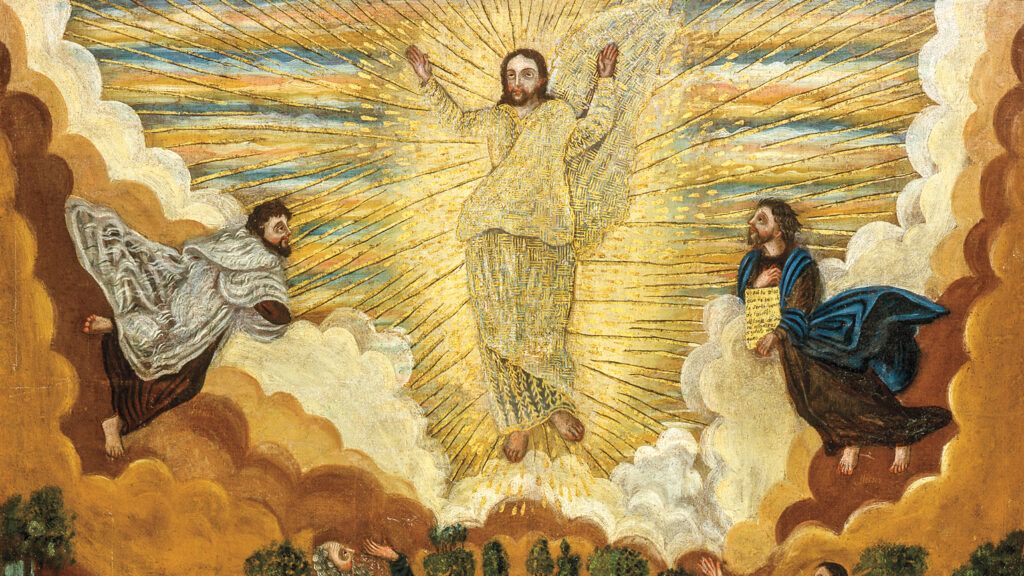Whenever I think about the Transfiguration, my mind travels back to the fifth- and sixth-grade Sunday school class I once coached to act it out for the congregation. The task seemed nearly impossible.
Why? Because this particular Bible story is filled with intangible elements. Jesus ascended from a mountaintop before three of his disciples and was transformed, his face shining like the sun, his clothes a dazzling white. The prophets Moses and Elijah appeared beside him, an even brighter cloud overshadowing all. A voice proclaimed, “This is my Son, the Beloved; with him I am well pleased; listen to him!”
Afterward, the three disciples—Peter, James and John—wanted to build something on the spot to commemorate the extraordinary event. Jesus turned them down. Then he told them not to speak of what they’d seen until after he died.
In the Sunday school class, I read the passage aloud, hoping to be inspired myself, then looked at the thoughtful young faces, pondering what they’d just heard.
“Isn’t it about God being light?” asked one. “Let’s use flashlights to act it out.”
“It’s on a mountaintop. What about building a mountaintop out of a cardboard box?” suggested another.
Like the disciples, our first reaction was to try to make sense of this miracle. To break it down into understandable bits. But it’s best looked at as a whole, wondrous encounter. In fact, it’s exactly its inexplicability—its heavenly, almost unrelatable nature—that makes the Transfiguration stick out in the three Gospel accounts in which it appears. Until this point, Jesus, the Teacher, or Rabbi, as his disciples called him, had preached using the most down to-earth language and relatable stories. He described a shepherd in search of a lost sheep, a woman looking for a lost coin, a father reuniting with a lost son. His listeners lived close to the land, and that’s what Jesus referred to most—the harvest, grain ripening, a tree without figs. When he did something miraculous, such as feeding 5,000 with only five loaves and two fish, his followers saw the evidence. Twelve baskets held leftovers. It wasn’t just their imagination. More than enough bread and fish had multiplied from almost nothing. The miracles were credible because they were tangible.
Not the Transfiguration. In the Gospel of Matthew, right before it happened, Peter had correctly answered who Jesus was. “You are the Christ,” Peter said. Then Jesus explained that he would be rejected by the elders, chief priests and scribes. He would be killed, then rise from the dead three days later. Peter objected, earning Jesus’ sharp rebuke: “Get behind me, Satan!” Perhaps that’s why Jesus orchestrated the Transfiguration—without it, his death and Resurrection would be too much to take in. As if to say, “I’m going to show the three of you something pretty outrageous, and I want you to watch. Not only will you see me as you’ve never seen me before, but you’ll hear something too. You’ll want to reflect on what it means for a long time.”
It’s important to note that the disciples who witnessed this divine moment were ordinary people. They were not scholars, not wealthy, not nobility; they were common laborers, fisher folk, men who used their hands to make a living. No one would have sought them out to behold a visionary experience. A reminder that God can appear to any one of us.
That it all happens on top of a mountain is also significant. Moses went to a mountaintop to hear God and receive the 10 Commandments. Jesus delivered mountainside teachings collectively known as the Sermon on the Mount. Mountains were holy places, where God’s word was heard. When Moses and Elijah—the prophet who made his exit from earth riding a chariot into the sky—appeared beside Jesus in the Transfiguration, there is a hint of Jesus’ own assumption to heaven.
At the time of the disciples’ vision, Jesus was very much earthbound. God in human form, exhorting his followers with words and actions. Yet, for a fleeting instant, he was transformed in blinding light. We call it the Transfiguration because of the change that came over Jesus, but I would argue he’s not the only one changed. The disciples were changed too. So are we.
When I revisit this story, I think of that class and what the experience taught me. With our flashlights, cardboard mountaintops and a kid speaking in a low, affected manner into the loudspeaker as the voice of God, we got the point across. God is not only light, but he speaks. He reveals himself to us—sometimes in weird, mystical visions—when we are ready to ascend our spiritual mountaintops.
I can imagine Peter, James and John rubbing their eyes after the Transfiguration, wondering if it had really happened. Jesus was back on earth and in his usual clothing. Everything was as before. Or was it? The group descended the mountain, and Jesus gave final instructions: “Tell no one about the vision until after the Son of Man has been raised from the dead.”
Mystery can be hard to take in. I find the mystery of Jesus’ death and Resurrection very hard to comprehend. But the Transfiguration is a reminder: Don’t overthink. Just experience the wonder of God. Reflect on that moment a bit. Take this chance to become transformed. There is time later to share what you’ve seen.





